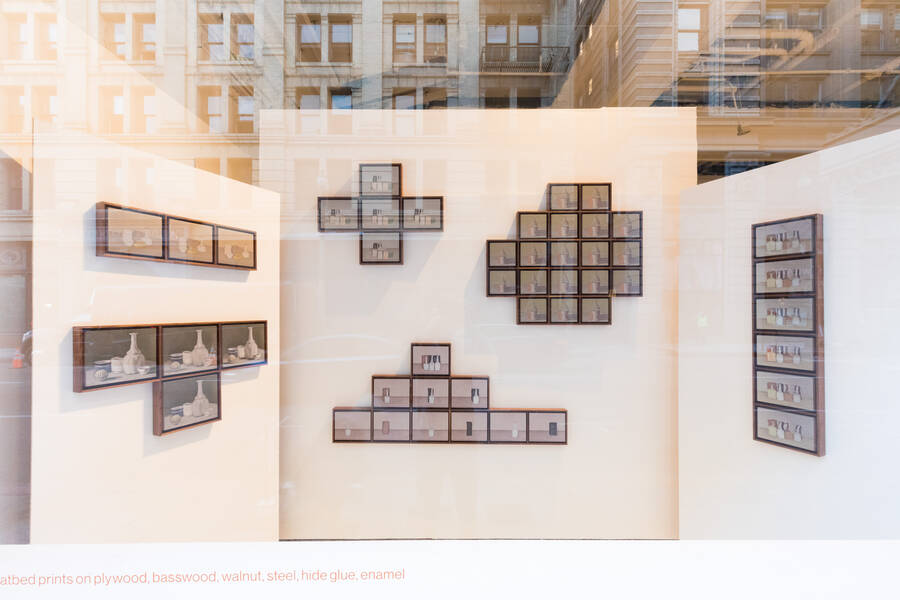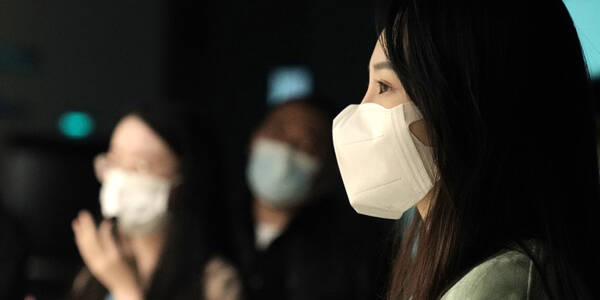
feature / exhibitions / spring-2021
March 16, 2021
By Mike Winder
Photos by Juan Posada
The Show Must Go On: In The Face of the Pandemic, ArtCenter's Exhibitions March Forward
Currently installed at the Williamson Gallery at ArtCenter’s Hillside Campus, the exhibition SKY explores how scientific discoveries have altered our understanding of reality. Objects on view include a rare copy of Nicolaus Copernicus’ 1543 publication De revolutionibus orbium coelestium (On the revolutions of the heavenly spheres), on loan from The Caltech Archives, and Carol Saindon’s Outside of Inside (2019), a 22-foot-long installation featuring shattered glass assembled into galactic forms on the floor.
The exhibition opened in February of last year and was scheduled to end in August. That was the plan, anyway, before COVID-19 hit Southern California, forcing the closure of the College last March. In that moment, and in the weeks and months that ensued, many things we had taken for granted went up in the air. In an essay written for the exhibition’s brochure, curator and Vice President of Exhibitions Stephen Nowlin (MFA 78 Fine Art) mused presciently on the “circadian deceptions” that we as humans have come to accept in our lives: “The sun rises and sets (which it doesn’t), the moon sets and rises (which it doesn’t) and the stars swirl around us (which they don’t).”

A year later, the College is still nearly empty, with students, faculty and most staff studying or working remotely. Though the gallery housing SKY is closed to the public, the objects remain very much on display. In fact, they’re being visited by some very special guests.
In November of 2020, ArtCenter invited three cosmologists—Alina Kiessling, Agnès Ferté and Dida Markovic, all astrophysicists at NASA’s Jet Propulsion Laboratory—to walk through the gallery, view the work on display and share their thoughts on what it means to be a scientist. All of this eventually culminated in "SKY Stories: Cosmologists Occupy an Art Space," a series of short videos that the College posted on YouTube earlier this year. “Copernicus, Galileo, Einstein—their names are in the books, they’re defying their own ends, defying space and time,” says Ferté in one video, contrasting her childhood ambition of immortality to her adult understanding of impermanence. “Now I understand [that] everything changes. Eternity is not possible.”
What made Ferté’s visit possible was both the generosity of the objects’ donors and the logistical challenges of moving delicate works of art during a pandemic. “We’ve had dancers, opera singers and storytellers in the gallery,” says Nowlin, when asked about the novelty of having astrophysicists pondering life’s big questions in front of artwork at the Williamson. “We even invited an audience to a walk-through of guest curator Jay Belloli’s 2017 Mars: Astronomy and Culture exhibition with a group of scientists. The idea of using the exhibition as a stage for performance is not new.”
Meanwhile, across town at South Campus, something newish is afoot at the Mullin Gallery. The regular cacophony—rumbling Metro buses, clanging light-rail crossing bells, traffic from the Harbor Freeway, the occasional parking lot bagpipe player—has been reduced to a low hum.
After being delayed four months due to the pandemic, Julia Christensen’s Upgrade Available opened in September 2020 in the gallery situated in the lobby of the College’s 1111 building. Bringing together nearly 50 works by Christensen, the exhibition explores how the relentless upgrade cycle of electronics impacts our collective sense of time. Upgrade Available includes photographs Christensen took of obsolete media, including videotapes, audiocassettes, film canisters, and 3.5” and 5.25” floppy disks. Documented in these photos are boxes holding the Los Angeles County Museum of Art’s media archives, which the artist captured as a fellow in LACMA’s Art + Tech Lab. The rub is that visitors can only see works through the gallery's windows on Arroyo Pkwy.
Adjusting to the moving goalposts created by COVID-19 has been a challenge, admits Senior Curator Julie Joyce, who started working in ArtCenter’s Exhibitions Department in September 2019, after serving as curator of Contemporary Art at the Santa Barbara Museum of Art for 11 years. “Julia’s show is beautiful, and I get to hear it every time I go in to water the plants,” says Joyce with a laugh, referencing the exhibition’s prototype of Christensen’s Tree of Life, a project the artist is developing with NASA’s Jet Propulsion Laboratory in which satellites and trees will communicate with one another via audible radio signals. Live trees outfitted with antennae are part of the show. “Hopefully soon people will get to walk into the gallery for a closer look,” Joyce says.

Ten miles away at ArtCenter DTLA, visitors are also able to see artwork in person. There, at the College’s flexible satellite location in Los Angeles’ Old Bank District, a series of four exhibitions under the Fractal Views banner—organized by Love’s Remedies, ArtCenter DTLA’s first artist-in-residence—began appearing in the space’s windows in October.
Viewing the pieces only from the sidewalk and through a pane of glass, socially distanced visitors were nevertheless able to see brand-new works created in 2020 by L.A. artists. The works have included Sharon Louise Barnes’ explosive yet meditative mixed media painting Music is What We Make of Music’s Absence (after Fred Moten); Eric Magaña’s Adobe House, a re-creation of the ruins of his mother’s house in Mexico; and Narges Noroozi’s Reconstructing a Recurring Dream, an installation made from bathroom architecture, water and soil.
“I know running ArtCenter’s space in downtown L.A. means I’m a culture gatekeeper,” says Program Director Christina Valentine (MA 01 Art Criticism and Critical Theory), who, prior to joining the Exhibitions team in September 2019, taught criticism and theory at the College and worked at UCLA’s Hammer Museum. “I want to make sure I’m opening up, not hindering, opportunities for local artists.”
Though Valentine realized the window exhibitions were providing a space for local artists during a time when opportunities were scarce, it was the passing locals giving her installation team a thumbs-up that made her realize they were making an impact. “In that neighborhood, in the past year, stores have closed and restaurants have shuttered,” says Valentine. “It was great to see how a gesture as small as creating an exhibition window series can make a difference.”
Being able to see into a gallery from the street is often construed as a negative, says John David O’Brien, an Exhibitions staff member and Integrated Studies faculty member, who recently curated In Verbis Artis, an exhibition at the Hoffmitz Milken Center for Typography (HMCT) at South Campus. “But after seeing people congregate outside our windows, I suspect we may start using that permeability to our advantage,” he says. “We might see the ‘white cube’ gallery experience of the last 30 years turn into something less isolating.”
In Verbis Artis, which explored the relationship between typography, design and fine art through the work of L.A.-based artists, opened in late February 2020 and had to close just a few short weeks into its run. The works on view—all which required viewers to slow down and closely inspect them to uncover multiple layers of messaging—included Mark Steven Greenfield’s Nightmare (2001), featuring an image from historical blackface theater, with the text “Whatchoo lookin at muthafukkha” layered atop it like an eye chart; and Rebecca Ripple’s mixed media work Sole (2020), which incorporated a giant insole draped over a clothing rack.
When the pandemic shut the exhibition down, it was up to Lavinia Lascaris (MFA 18 Graphic Design), HMCT’s exhibition and graphic designer, to bring In Verbis Artis online. As part of her solution, Lascaris created a video tour of the exhibition and assembled a more robust presentation of the experience for the HMCT website. “It’s been interesting to find workarounds,” says Lascaris, who believes that all exhibitions, from here on out, whether in a pandemic or not, will need a strong online presence. “Being online means reaching an audience that wouldn’t normally be inside our gallery.”
Attracting new audiences is something that HMCT—an educational space founded in 2015 that presents workshops, lectures, exhibitions and more related to the study of typography and letterform design—has long had as a goal. “The intention of making HMCT transparent was so that people on the outside could see what was happening inside,” says Professor Gloria Kondrup (MFA 93 Graphic Design), founding executive director of the HMCT, referring to the space’s wall of windows facing Raymond Ave. “We wanted to show the community the exciting things that were happening at ArtCenter.”
For three months, starting in July 2020, what people passing HMCT could see—once the sun went down—was Great Writers/Orators/Artists: A Typographic Narrative, a collection of motion graphic works created in 2019 by Graduate Graphic Design students as part of a course taught by Tyrone Drake (BFA 96 Graphic Design). Among the works presented were Angad Singh’s Implication of Time, which riffed on nonlinear time as presented in the films of Christopher Nolan, and Yu Chen’s Jean Baudrillard, which explored concepts posited by the French philosopher most famous for his 1981 publication Simulacra and Simulation.
Great Writers was just one element in a three-part exhibition series titled Up All Night, which arose spontaneously as a response to the pandemic. At three campus locations—HMCT, ArtCenter DTLA and the Mullin Gallery—outward-facing monitors displayed a different curated selection of works, ranging from whimsical animation to provocative video art.
The title Up All Night was born from a conversation between Valentine and Joyce in which they realized that due to the pandemic, they, as well as many of their colleagues, were having trouble sleeping. “We were at the beginning stages of uncertainty,” says Valentine. “And we wanted to create something that captured the range of emotions associated with being up all night, both before and during COVID.”
The series included an exhibition of single-channel video works titled Face Time, curated by Joyce and Valentine, that contemplated isolation. One comic yet unsettling example was Nina Katchadourian’s Mystic Shark (2007), in which the artist placed petrified shark teeth in her mouth to affect an awkward anthropomorphism. The series also included an exhibition of animated shorts from recent students in the Entertainment Design program. In one, Hantine Hsu’s (BS 20) Rambling Man, a woman in an abusive relationship drifts off to sleep and enters a world of fantasy.
“Up All Night was Christina’s idea, which she shared with us all, and it was interesting to see the different character the exhibition took on at each of the different spaces,” says Joyce, who was pleased with how the exhibition brought together colleagues from across the College with the goal of creating something special for the community. “For me, personally, that inspired me during a downtime.”
To see Fractal Views, In Verbis Artis, SKY, Up All Night, Upgrade Available and more, visit artcenter.edu/exhibitions.
















